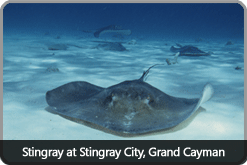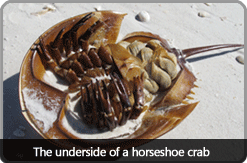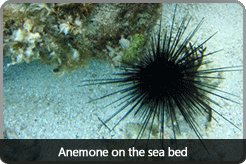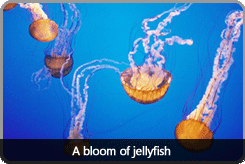The ocean biome contains some of the most varied ecosystems, and as such we can find many organisms here producing biotoxins. This page only contains but a few examples of these.

The stingray, a member of the suborder Myliobatoidei, is a flat-bodied, cartilaginous, bottom dwelling fish related to the shark, which is noted for its long spiny tail. It is these barbed spines that carry the venom (which is a nerve toxin) that stingrays use in self-defence, when they feel threatened. The venom is carried in two glands on the underneath of the spine, and the venom is concentrated in the skin around the spine – therefore, when the spine penetrates another organism, the venom enters directly into their skin, and can cause a very painful wound which may or may not be fatal, depending on the area penetrated.

Lionfish, from the Pterois genus, are fish recognisable for their unusual poisonous spiked fins and tentacles all over their bodies, which are used for defence and not for catching prey. They have strong venom, making them dangerous to swimmers and fisherman around the reefs that they live in, and can cause extreme pain followed by nausea and fever in humans (although this rarely results in death). However, even though these fish are known for being poisonous, they are still used in cooking around the world.
Limulus polyphemus, the horseshoe crab, is a marine arthropod that is actually closer related to spiders and scorpions than crabs. It is considered a living fossil. Sometimes, tetrodotoxin (a very potent poison) can be found in the gonads of horseshoe crabs that inhabit the area around Thailand. If this is eaten, due to improper preparation, poisoning can occur and the toxin will interfere with nerve signals to muscles, causing muscle paralysis and even death. As well as this, the crab's blood is used in tests to detect the presence of endotoxins, due to it containing a protein called LAL (Limulus Amebocyte Lysate), which clots on contact with toxins. The use of this test helps to prevent bacteria adhering to medical equipment and potentially causing infection. The LAL test also has the ability to sense and indicate cancerous cells – and so could be useful in the development of new treatments which might involve endotoxins.


Sea anemones, although they might look like a type of water plant, are actually predatory animals that live under the sea. They are a type of cnidarian and so are closely related to jellyfish and corals. They have special cells known as nematocysts, which are stinging cells (have vesicles filled with toxins) and help the anemone to catch its prey. They are activated once something touches a hair on the outer surface of the cell, and produce a miniature explosion of neurotoxin which targets the passing organism (such as a fish or a shrimp) and paralyses it. The paralysed prey will then be passed into the mouth by a tentacle.

Jellyfish are also a member of the Cnidaria phylum, and individuals as old as 500 million years have been found. They are a free swimming but planktonic (can't swim again the current) species which can be found in every body of water around the world – however only those that live in seawater are able to sting. Like sea anemones, they also sting their prey using nematocysts, injecting their poison into the skin of their victim. Some jellyfish are so toxic that they can still sting when beached or dead, and so it is wise to avoid jellyfish wherever possible without protection.
The cone snail is a mostly tropical, venomous, snail which has a colourfully patterned shell, and there are many species of them. Some species can be very hazardous to humans, particularly the larger ones. These snails will use a tooth, called a radula tooth which projects from the throat (it looks like a dart or a needle) to attack and inject venom into their prey, which will then paralyse the victim. They can also fire darts like this in all directions, and this is often how humans are injured by them. If the victim is a small fish or other marine organism, it will then be draw in by the snail to be eaten. If it is a human affected, these toxins can cause anything from a small sting to a serious condition that can sometimes be fatal. One of the largest cone snails, the geographic cone snail, is incredibly poisonous and the chances of human survival after being stung are only 30%, as there is no antidote available. The venom of cone snails is made up of many different toxins (up to 200), all of them neurotoxins which attack the nerves and block receptors – this is what causes the paralysis. Research is now showing that the toxins in cone snail venom have similar properties to morphine (as they block nerves and so the pain sensation), and so could be of some help in developing painkillers in the future, more specifically to cancer sufferers.

